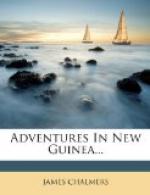When we reached the lagoon, a catamaran with three natives on it came off to us. We asked for Koitan, the chief, which at once gave them confidence in us, so that they came alongside, one getting into the boat. He expressed his friendship to us in the usual way, viz. by touching his nose and stomach, and, being very much excited, seized hold of Mr. McFarlane and rubbed noses with him, doing the same to me. He received a present of a piece of hoop-iron and some red braid, which greatly pleased him. We found the water was deep enough over the reef for the vessel, and good anchorage inside. We went on to the village, to see about the supply of water.
The people were very friendly, and crowded round us. We were led up to a platform in front of one of their large houses, and there seated and regaled with cocoanuts. The natives here are much darker than are those at Kerepunu; most of them suffer from a very offensive-looking skin disease, which causes the skin to peel off in scales. In their conversation with one another I recognized several Polynesian words. The water is obtained by digging in the sand, and is very brackish.
We came to anchor next morning, and soon were surrounded with canoes, and our deck swarmed with natives trading their curios, yams, cocoanuts, and fish for beads and hoop-iron. Many were swearing friendship, and exchanging names with us, in hopes of getting hoop-iron. There is as great a demand for hoop-iron here as for tobacco at Port Moresby. They told us they disliked fighting, but delighted in the dance, betel-nut, and sleep. The majority have jet black teeth, which they consider very beautiful, and all have their noses and ears pierced, with various sorts of nose and ear rings, chiefly made from shell, inserted. A crown piece could easily be put through the lobe of their ears.
We went ashore in the afternoon. There are three villages, all close to one another. Their houses are built on poles, and are shaped like a canoe turned bottom upwards, others like one in the water. They ornament their houses on the outside with cocoanuts and shells. The nabobs of the place had skulls on the posts of their houses, which they said belonged to the enemies they had killed and eaten. One skull was very much fractured; they told us it was done with a stone axe, and showed us how they used these weapons.
We tried to explain to them that no one was to come to the vessel the next day, as it was a sacred day. In the early morning, some canoes came off to trade, but we sent them ashore; a few more followed about breakfast-time, which were also sent ashore. In the afternoon, our old friend of the preceding day came off, with his wife and two sons. He called out that he did not wish to come on board, but that he had brought some cooked food. We accepted his present, and he remained with his family in his canoe alongside the vessel for some time, and then went quietly ashore. We had three services on board, one in the forenoon in Lifuan, in the afternoon in Rarotongan, and in the evening in English.




